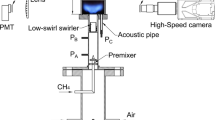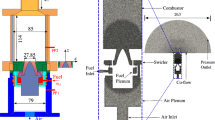Abstract
The dynamics of a laminar premixed stagnating flame subjected to simultaneous velocity and equivalence ratio oscillations are investigated experimentally. A flame of premixed methane and air is formed in a wall-stagnating flow. The oscillations of velocity and equivalence ratio are imposed independently by two sets of dual cylinder–piston oscillators. To impose the equivalence ratio oscillation, methane/air mixtures with equivalence ratios of \(\phi =1.0\) and \(0.4\) are supplied to different cylinder–piston units. The pistons move in anti-phase and create a sinusoidal equivalence ratio oscillation while keeping the volume flow rate constant. To impose the velocity oscillation, a mixture with \(\phi =0.7\) is supplied to the single unit of another oscillator. The phase difference between the two oscillations is set by changing the relative position of the pulley teeth of the two oscillators. The oscillator frequency is varied between 2 and 20 Hz, meaning that the oscillation wavelengths are much longer than the flame thickness. When frequencies of the velocity and equivalence ratio fluctuations are in a quasi-steady state condition, the flame motion is affected independently by velocity oscillation and equivalence ratio oscillation and the linear-superposition assumption can be applied. When the velocity and equivalence ratio oscillation frequencies are increased and exceed the transition frequency from the quasi-steady state to unsteady state, the flame motion gradually deviates from linear-superposition assumption. This is due to the variations in the unsteady molecular diffusion and the back-support effect.
Graphical abstract












Similar content being viewed by others
References
Candel S (1992) Combustion instabilities coupled by pressure waves and their active control. Proc Combus Inst 24:1277–1296
Candel S (2002) Combustion dynamics and control: Progress and challenges. Proc Combust Inst 29:1–28
Candel S, Durox D, Schuller T, Darabiha N, Hakim L, Schmitt T (2013) Advances in combustion and propulsion applications. Eur J Mech B/Fluids 40:87–106
Ćosić B, Terhaar S, Moeck JP, Paschereit CO (2015) Response of a swirl-stabilized flame to simultaneous perturbations in equivalence ratio and velocity at high oscillation amplitudes. Combust Flame 162:1046–1062
Ducruix S, Schuller T, Durox D, Candel S (2003) Combustion dynamics and instabilities: Elementary coupling and driving mechanisms. J Propulsion Power 19:722–734
Egolfopoulos FN, Zhang H, Zhang Z (1997) Wall effects on the propagation and extinction of steady, strained, laminar premixed flames. Combust Flame 109:237–252
Epstein AH (2012) Aircraft engines’ needs from combustion science and engineering. Combust Flame 159:1791–1792
Hirasawa T, Ueda T, Matsuo A, Mizomoto M (1998a) Effect of oscillatory stretch on the flame speed of wallstagnating premixed flame. Symp Combust 27:875–882
Hirasawa T, Ueda T, Matsuo A, Mizomoto M (1998b) Wall stagnating flow near the wall oscillated parallel to the flow. Nihon Kikai Gakkai Ronbunshu, B Hen/Transactions of the Japan Society of Mechanical Engineers, Part B 64(624):2683–2689
Hirasawa T, Ueda T, Masuo A, Mizomoto M (2000) Response of flame displacement speeds to oscillatory stretch in wall-stagnating flow. Combustion and Flame 121:312–322
Ishida K (2003) Small and medium size gas turbines, Buletin of GTSJ 2003
Karimi N (2014) Response if a conical, laminar premixed flame to low amplitude acoustic forcing—a comparison between experiment and kinematic theories. Energy 78:490–500
Karimi N, Brear MJ, Jin SH, Monty JP (2009) Linear and non-linear forced response of a conical, ducted, laminar premixed flame. Combust Flame 156:2201–2212
Kawasaki D, Kashiwagi K, Yokomori T, Ueda T (2016) Extinction phenomenon of laminar stagnating lean premixed flame with fuel concentration oscillation. Mech Eng Lett 2:16–00334
Kim KT (2016) Combustion instability feedback mechanisms in a lean-premixed swirl-stabilized combustor. Combust Flame 171:137–151
Kim KT, Lee JG, Quay BD, Santavicca DA ( 2010) Response of partially premixed flames to acoustic velocity and equivalence ratio perturbations. Combust Flame 157:1731–1744
Kim KT, Lee JG, Quay BD, Santavicca DA (2011) Reconstruction of heat release response of partially premixed flames. Combust Sci Technol 183:122–137
Lieuwen T, Zinn BT (1998) The role of equivalence ratio oscillations in driving combustion instabilities in low NOx gas turbines. Symp Combust 27:1809–1816
Lieuwen T, Torres H, Johnson C, Zinn BT (2001) A mechanism of combustion instability in lean premixed gas turbine combustors. Journal of Engineering for Gas Turbines and Power 123:182–189
Lieuwen T (2012) Unsteady Combustor Physics 1st Edition
Matsuyama R, Kobayashi M, Ogata H, Horikawa A, and Kinoshita Y (2012) Development of a lean staged combustor for small aero-engines. ASME Turbo Expo 2012: Turbine Technical Conference and Exposition, (2): Combustion, Fuels and Emissions, Parts A and B (No. GT2012-68272) 211-218
Rahman MRA, Yokomori T, Ueda T (2015) Model of flame dynamics of laminar premixed flame subject to the low frequency equivalence ratio oscillations. International Communications in Heat and Mass Transfer 61:8–15
Rayleigh L (1878) The explanation of certain acoustical phenomena. Nature 18:319–321
Schuller T, Durox D, Candel S (2003) A unified model for the prediction of laminar flame transfer functions: comparisons between conical and V-flame dynamics. Combustion and Flame 134:21–34
Stöhr M, Yin Z, Meier W (2017) Interaction between velocity fluctuations and equivalence ratio fluctuations during thermoacoustic oscillations in a partially premixed swirl combustor. Proceedings of Combustion Institute 36:3907–3915
Suenaga Y, Yanaoka H, Kikuchi M, Kikuchi T (2018) Dynamic response of wall-stagnating lean methane-air premixed flame to equivalence ratio oscillation. Journal of Thermal Science and Technology 13:17–00552
Tomita H, Rahman MRA, Miyamae S, Yokomori T, Ueda T (2015) Flame dynamics of equivalence ratio oscillations in a laminar stagnating lean methane/air premixed flame. Proceedings of Combustion Institute 35:989–997
Author information
Authors and Affiliations
Corresponding author
Additional information
Publisher’s Note
Springer Nature remains neutral with regard to jurisdictional claims in published maps and institutional affiliations
Rights and permissions
About this article
Cite this article
Niwa, Y., Okamoto, M., Yokomori, T. et al. Effect of simultaneous velocity and equivalence ratio oscillations on a laminar premixed stagnating flame. Exp Fluids 60, 107 (2019). https://doi.org/10.1007/s00348-019-2729-y
Received:
Revised:
Accepted:
Published:
DOI: https://doi.org/10.1007/s00348-019-2729-y




